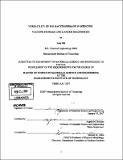| dc.contributor.advisor | Angela M. Belcher. | en_US |
| dc.contributor.author | Shi, Amy (Amy J.) | en_US |
| dc.contributor.other | Massachusetts Institute of Technology. Dept. of Materials Science and Engineering. | en_US |
| dc.date.accessioned | 2007-08-29T20:31:05Z | |
| dc.date.available | 2007-08-29T20:31:05Z | |
| dc.date.copyright | 2007 | en_US |
| dc.date.issued | 2007 | en_US |
| dc.identifier.uri | http://hdl.handle.net/1721.1/38583 | |
| dc.description | Thesis (S.M.)--Massachusetts Institute of Technology, Dept. of Materials Science and Engineering, 2007. | en_US |
| dc.description | Includes bibliographical references (p. 88-94). | en_US |
| dc.description.abstract | Two novel ways of engineering the filamentous bacteriophage, M13, for the prevention, diagnosis, and treatment of human disease are proposed. Both ways are founded on the unique structural properties of the M13 bacteriophage and the ability of its major and minor coat proteins, p3 and p8, to be manipulated to serve as virus-based multifunctional platforms. The first project addresses the problem of vaccine storage and the cold chain (requirement to store vaccines at 2-80C or lower). The need for refrigeration leads to high cost, difficult field delivery, and high potential for vaccine instability. By capitalizing on the liquid crystalline nature and unique diffraction patterns of phage films, we aim to encapsulate vaccines in a 3-D liquid crystalline matrix that would not only allow for stability at elevated temperatures but would also allow for easy detection of viability by using a laser light and noting the diffraction pattern. We chose luciferase as a model for a protein-based vaccine, and found several phage-borne peptide sequences with increased affinity to luciferase compared to controls. Two of these sequences, CKLHGTSRC and CTHKNQAC were chosen to form luciferase-encapsulated phage films. The second project addresses the need of more sensitive imaging techniques for early detection of cancer. | en_US |
| dc.description.abstract | (cont.) M13 bacteriophage were used in combination with quantum dots and magnetic nanoparticles as bigger and brighter markers for cancer lesions. A 100% expressed p8 library was created for screening against potential cancer markers and work will soon proceed with screening against several cancer cell lines. In addition, a Type 83 phage was created that had a sequence directed against vascular cell adhesion molecule-1 (VCAM-1) expressed on the p3 and a tri-glutamate sequence (E3) on the p8 that could bind well to positively charge molecules like amines. Successful attachment of amine-terminated CdSe/ZnS quantum dots to p8E3 phage (E3 on p8 and wildtype on p3) was shown and III-V quantum dots (GaN and InN) were water solubilized for use in vivo. The goal is to combine all parts and start in vivo testing and screening, as well as to expand our cancer targeting repertoire. | en_US |
| dc.description.statementofresponsibility | by Amy Shi. | en_US |
| dc.format.extent | 94 p. | en_US |
| dc.language.iso | eng | en_US |
| dc.publisher | Massachusetts Institute of Technology | en_US |
| dc.rights | M.I.T. theses are protected by copyright. They may be viewed from this source for any purpose, but reproduction or distribution in any format is prohibited without written permission. See provided URL for inquiries about permission. | en_US |
| dc.rights.uri | http://dspace.mit.edu/handle/1721.1/7582 | |
| dc.subject | Materials Science and Engineering. | en_US |
| dc.title | Versatility of M13 bacteriophage in medicine : vaccine storage and cancer diagnostics | en_US |
| dc.type | Thesis | en_US |
| dc.description.degree | S.M. | en_US |
| dc.contributor.department | Massachusetts Institute of Technology. Department of Materials Science and Engineering | |
| dc.identifier.oclc | 156793003 | en_US |
